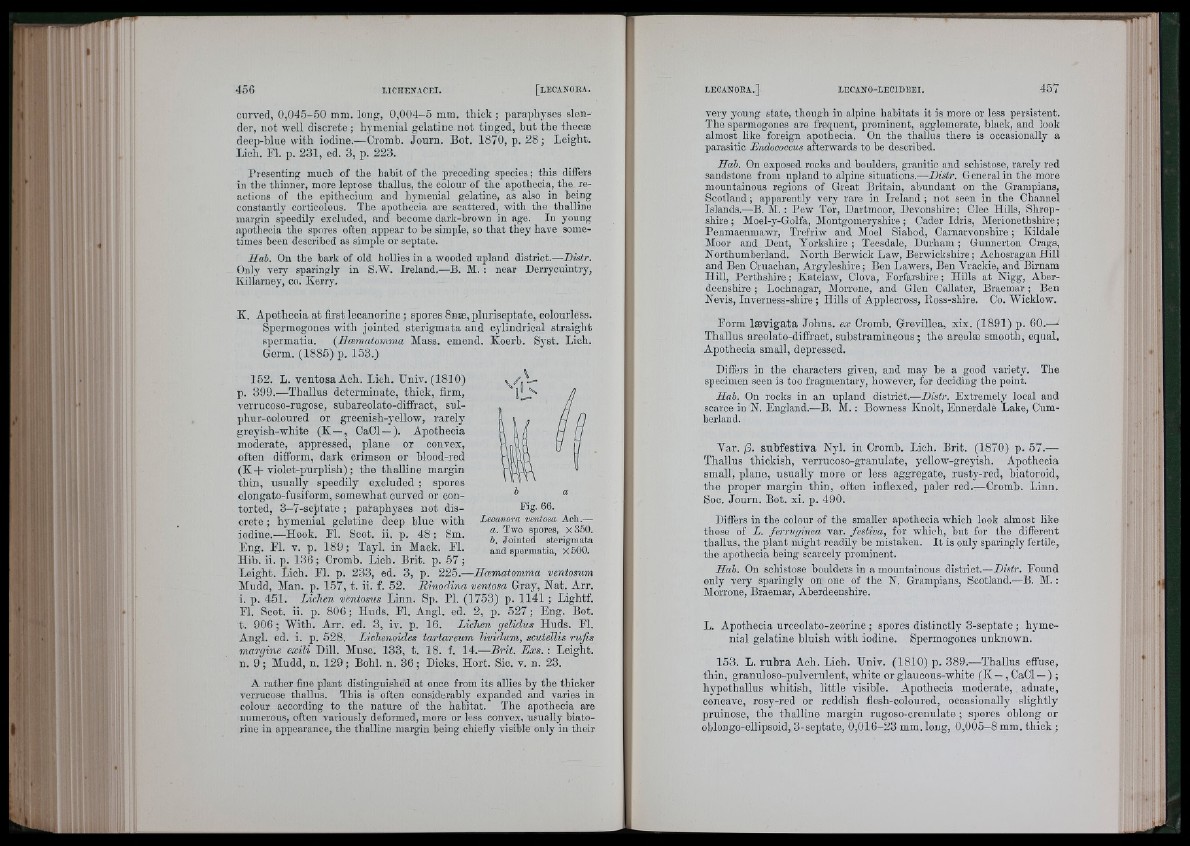
curved, 0 ,0 4 5 -5 0 mm. long, 0 ,0 0 4 -5 mm. tliick ; paraphyses slender,
not well discrete ; hymenial gelatine not tinged, bu t th e theoæ
deep-blue with iodine.—Cromb. Journ. Bot. 1870, p. 2 8 ; Leigbt.
Lioh. Fl. p. 231, ed. 3, p. 223.
Presenting much of tbe habit of the preceding species ; this differs
in tlie tliinner, more leprose thallus, the colour of the apothecia, the reactions
of the epithecium and liymenial gelatine, as also in being
constantly corticolous. The apothecia are scattered, with the thalline
margin speedily excluded, and become dark-brown in age. In young
apothecia the spores often appear to be simple, so that they have sometimes
been described as simple or septate.
Hab. On the bark of old hollies in a wooded upland district.—Histr.
Only very sparingly in S.W. Ireland.—B. M. : near Derrycuintry,
Killarney, co. Kerry.
K. Apothecia a t first leoanorine ; spores 8noe, p luriseptate, colourless.
Spermogones with jo inted sterigm ata and cylindrical stra ig h t
spermatia. {Hcematomma Mass. emend. Koerb. Syst. Lich.
Germ. (1885) p. 153.)
152. L. v en to s aA ch . Lich. Univ. (1810)
p. 399.—Thallus determinate, thiok, firm,
verrucoso-rugose, subareolato-diffraot, sulphur
coloured or greenish-yellow, rarely
greyish-white (K —, CaCl — ). Apothecia
moderate, appressed, plane or convex,
often difform, dark crimson or blood-red
(K + v io le t-p n rp lis h ); th e thalline margin
th in , usually speedily excluded ; spores
elongato-fusiform, somewhat curved or contorted,
3 -7 -s e p ta te ; paraphyses not discrete
; hymenial gelatine deep blue witb
Fig. 66.
Lecanora ventosa Ach.—
a. Two spores, x350.
b. Jointed sterigmata
and spermatia, X 500.
iodine.—Hook. Fl. Soot. ii. p. 48 ; Sm.
Eng. El. V. p. 1 8 9 ; Tayl. in Mack. F l.
Hib. ii. p. 136 ; Cromb. Lich. Brit. p. 57 ;
Leight. Liob. Fl. p. 233, ed. 3, p. 225.—Hcematomma ventosum
Mudd, Man. p. 157, t. ii. f. 52. SinocHna ventosa Gray, Nat. Arr.
i. p. 451. Lichen ventosus Linn. Sp. PI. (1753) p. 1141 ; Lightf.
Fl. Scot. ii. p. 806 ; Huds. F l. Angl. ed. 2, p. 527 ; Eng. Bot.
t. 9 0 6 ; W ith . Arr. ed. 3, iv. p. 16. Lichen gelidus Huds. Fl.
Angl. ed. i. p. 528. Lichenoides tartareum lividum, scutellis rufis
margins exili Dill. Muso. 133, t. 18. f. 14.—B r it. E xs. : Leight.
n. 9 ; Mudd, n. 129 ; Bohl. n. 36 ; Dicks. Ho rt. Sio. v. n. 23.
A rather fine plant distinguished at once from its allies by the thicker
verrucose thallus. This is often considerably expanded and varies in
colour according to the nature of the hahitat. The apothecia are
numerous, often variously deformed, more or less convex, usually biatorine
in appearauce, the thalline margin being cbiefly visible only iu their
very young state, though in alpine habitats it is more or less persistent.
The spermogones are frequent, prominent, agglomerate, black, and look
almost like foreign apotbecia. On the thallus there is occasionally a
parasitic Endococcus afterwards to be described.
Hab. On exposed rooks and boulders, granitic and schistose, rarely red
sandstone from upland to alpine situations.—Distr. General in the more
mountainous regions of Great Britain, abundant on the Grampians,
Scotland ; apparently very rare in Ireland ; uot seen in tbe Channel
Islands.—B. M. : Pew Tor, Dartmoor, Devonshire ; Glee IliUs, Shropshire
; Moel-y-Golfa, Montgomeryshire ; Cader Idris, Merionethshire;
Penmaenmawr, Trefriw and Moel Siahod, Carnarvonshire ; Kildale
Moor and Dent, A'orkshire ; Teesdale, Durham ; Gunnerton Crags,
Northumberland. North Berwick Law, Berwickshire; Acbosragan Ilill
and Ben Cruachan, Argyleshire ; Ben Latvers, Ben A’rackie, and Birnam
Ilill, Perthshire ; Katelaw, Clova, Forfarshire ; Hills at Nigg, Aberdeenshire
; Lochnagar, Alorrone, and Glen Callater, Braemar ; Ben
Nevis, Inverness-shire ; Hills of Applecross, Ross-shire. Co. Wicklow.
Form lævigata Johns, ex Cromb. Grevillea, xix. (1891) p. 60.—
Tballus areolato-diffract, substramineous ; the areolæ smootb, equal.
Apotheoia small, depressed.
Differs in the characters given, and may be a good variety. The
specimen seen is too fragmentary, however, for deciding the point.
Hab. On rocks in an upland district.—Distr. Extremely local and
scarce in N. England.—B. M. : Bowness Knolt, Ennerdale Lake, Cumberland.
Var. p. subfestiva Nyl. in Cromb. Lioh. Brit. (1870) p. 57.—
Thallus thickish, verrucoso-granulate, yellow-greyish. Apotheoia
small, plane, usually more or less aggregate, rusty-red, biatoroid,
tb e proper margin thin, often inflexed, paler red.—Cromb. Linn.
Soo. Journ. Bot. xi. p. 490.
Differs in the colour of tbe smaller apotbecia which look almost like
those of L. ferruginea var. festiva, for which, but for tbe different
thallus, the plant might readily be mistaken. I t is only sparingly fertile,
the apothecia being scarcely prominent.
Hab. On schistose boulders in a mountainous district.—Distr. Found
only very sparingly on one of the N. Grampians, Scotland.—B. AI. :
Alorrone, Braemar, Aberdeenshire.
L. Apothecia urceolato-zeorine ; spores distinctly 3-septate ; bymenial
gelatine bluish witb iodine. Spermogones unkuowm.
153. L. r u b r a Ach. Lioh. Hniv. (1810) p. 389.—Thallus effuse,
th in , granuloso-pulverulent, white or glaucous-white (K — , CaCl — ) ;
hypothaUus whitish, little visible. Apothecia moderate, adnate,
concave, rosy-red or reddish flesh-coloured, occasionally slightly
pruinose, th e th allin e margin rugoso-orennlate ; S])ores oblong or
oblongo-ellipsoid, 3-septate, 0 ,0 1 6 -2 3 mm. long, 0 ,0 0 5 -8 mm. th ick ;
Î C
I 7? I 1 rii
• 1